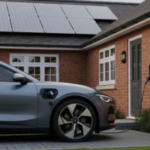
Flexible EV Charging Made Simple with Manual Scheduling
26 August 2025
Driving Growth Through Customer Experience in Next-Gen Energy
30 September 2025Powering the Electric Home
In this episode of Next Time Around, “What’s next for Energy Suppliers? Tech, tariffs, and customer satisfaction,” Michelle Little talks to Lauren Forster and Richard Britton about her own journey electrifying her home and what it revealed about the gap between industry ambition and everyday customer experience.
Michelle has spent over 20 years in the energy sector, working with major suppliers to shape the industry’s future.
The conversation covers everything that needs to change for more homes to make the leap to fully electric – from clearer communication to smarter, simpler technology.
Michelle doesn’t hold back: suppliers must move faster, tech needs to be easier to use, and the customer has to stay at the centre of it all.
Consumer choice and confidence
Switching to an electric home isn’t a one-size-fits-all decision. Everyone’s path to an electric home is different, and there’s no one right way to do it. As Michelle says,
“[…] the first thing I would say is research, research, research. I’m sure you would agree with that. If you’re thinking about getting an electric vehicle, I’m not going to tell everyone that it’s for them. Different people will have different needs.”
Getting practical experience makes a real difference. Michelle spends her weekends behind the wheel of different electric vehicles, learning what works in real life.
“I spend my weekend test driving electric vehicles, so if you want to know which one to get, I could bore you to death with some of that information. But for me, it starts with research. Understand your needs, your family, how much you’ll be driving, where you’ll be driving to and from, to understand what the right vehicle is.”
Customers aren’t foolish. They just need better tools and straightforward information. For the energy transition to succeed, people need to feel curious and in control, not overwhelmed.
The home as an energy hub
Michelle’s home shows how all the pieces of an electric household can come together to create a functional, everyday system.
“So at home, I have solar panels, I have battery storage, I have an EV, an EV charger, and I also have a heat pump, so we’re fully electric in our home.”
She sees it as more than just hardware. It’s also a shift in how a household interacts with energy, moving from passive use to active management.
“I’ve seen a cost saving. So there’s been quite a significant cost saving in the home. I also have a daughter, and for me, the benefit from this is knowing that I’m doing my bit to help change the world for the future and help decarbonise for the future”
When everything is integrated, it becomes part of everyday life and a source of pride. Yet for most people, taking that first step is still challenging.
Simplicity through software and AI
The technology to run an electric home is already available, but it’s spread across too many apps and platforms, making it complicated for most people.
“You now have seven apps to run your home. So software and AI is the thing that will make this work, because many people don’t want to have to manage seven apps.”
Managing multiple systems creates friction and frustration. Consumers want a home that just works—heated to the right temperature, powered efficiently—without juggling interfaces.
“The general consumer… wants to walk into a house that’s heated to the right temperature… [without] managing seven apps.”
Smart technology should be invisible, giving one simple, unified experience. AI can do the heavy lifting behind the scenes, offering tailored solutions so people don’t have to think about energy management at all.
That’s where Powerverse’s Energy Operating System (EOS) comes in. It links up your home energy systems, EV charger, solar panels, and battery storage so everything works together. EOS does the hard work automatically, helping homeowners enjoy smart energy without having to manage multiple apps or settings.
The benefits go beyond the homeowner. The EOS also helps your business unlock new value, providing the software and support you need to stay ahead in a rapidly evolving energy market.
The energy supplier wake-up call
Suppliers can’t just react to events. They need to take a more proactive approach, especially when it comes to intelligent EV charging and home energy solutions.
“Energy suppliers really need to use [smart meter] data and they really need to look at the technologies that are in people’s homes, because it’s not just the energy consumption from their lights and their heating.”
Innovation shouldn’t only happen in response to price spikes, customers expect reliable, consistent solutions.
“We’ve seen some really great innovation in this space, but there needs to be more, and there needs to be green, clean tariffs in [the] market.”
Right now, there is a gap between the convenient, cost-effective services people want and what most suppliers provide.
New challengers are already creating smoother, more intuitive digital experiences. Established companies need to catch up fast if they want to stay relevant.
Convenience is the dealbreaker
For most people, simplicity is everything. If switching to electric isn’t straightforward, it simply won’t happen. Lauren Forster expands on this:
“It’s something we always say, life these days, everything needs to be convenient. If it’s not convenient, people won’t buy into it.”
Energy upgrades need to feel as plug-and-play as any other service people use. Long delays or complicated installations only put people off.
“I actually know someone who purchased an EV on a bit of a whim in a garage showroom and has ended up returning it, because in the end, it’s a year later, [and] they’ve not been able to get an EV charger installed in their homes.”
From EV charging and home installations to digital dashboards, convenience is the red line. And tools like the Powerverse app help here too, quietly bringing everything together in one place so it just works.
No one wants to spend their time managing their electricity. It should just work.
Final thoughts
Electrifying the home isn’t just about installing hardware, it’s about creating an experience that people can actually live with. Technology is ready, but it only works if it’s simple, intuitive, and centred around real users.
“We’re already there [with tech], and people need to catch up.”
Michelle makes it clear that no single company can solve this alone. Customer-centricity, convenience, and collaboration need to go hand in hand to make the electric home a reality.
The future won’t just be about going electric. It will be about homes that are smart, human-first, and designed to make life easier for the people living in them.
Making the move to a fully electric home can feel complicated, but Powerverse is building the software to bring it all together. See it in action by booking a demo today.

